


NED (EDWARD) KELLY 1854 -
Acknowledgements
Kelly: 1800, artist unknown – Picture Collection, State Library of Victoria, Australia. Mask: date and artist unknown – Picture Collection, State Library of Victoria, Australia. Morgan: poster for the film Mad Dog Morgan, directed by the French-
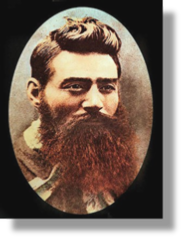 xxxxxIt was in 1878 that the famous Australian outlaw Ned Kelly -
xxxxxIt was in 1878 that the famous Australian outlaw Ned Kelly -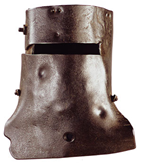 ing the arrest of his brother Daniel for horse stealing. The two brothers escaped, fled to the outback and, joined by two others, formed the Kelly gang. Over the next two years this gang carried out a series of daring bank raids and shootouts with the police in the border area between Victoria and New South Wales. The end came in 1880 after the gang had taken possession of a little hotel in the small township of Glenrowan. They were besieged by the police and eventually overcome. Kelly was wounded and captured, and his fellow gang members were killed. Later that year Kelly was tried, convicted and hanged. In this final battle the gang wore an assortment of home-
ing the arrest of his brother Daniel for horse stealing. The two brothers escaped, fled to the outback and, joined by two others, formed the Kelly gang. Over the next two years this gang carried out a series of daring bank raids and shootouts with the police in the border area between Victoria and New South Wales. The end came in 1880 after the gang had taken possession of a little hotel in the small township of Glenrowan. They were besieged by the police and eventually overcome. Kelly was wounded and captured, and his fellow gang members were killed. Later that year Kelly was tried, convicted and hanged. In this final battle the gang wore an assortment of home-
xxxxxKelly and his gang are seen as the last and the most notorious of the so-
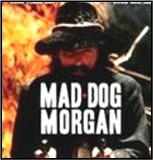
xxxxxThe attacks of these armed rebels had become so serious by the beginning of the 19th century that in 1815 martial law was proclaimed in New South Wales, and severe penalties were passed against their crimes. Raids continued however, and matters became worse with the discovery of gold in 1851. Gold shipments were targeted and bank robberies increased.
xxxxxHowever, whilst the majority of these outlaws were nothing short of callous murderers, there were those who caught the imagination of the public by sharing their booty with the poor or showing a certain amount of concern for their victims. And some of these brigands -
 xxxxxEdward (Ned) Kelly was born near the small township of Beveridge, close to Melbourne in the state of Victoria, the eldest son of Irish Catholic parents. His father, an ex-
xxxxxEdward (Ned) Kelly was born near the small township of Beveridge, close to Melbourne in the state of Victoria, the eldest son of Irish Catholic parents. His father, an ex-
xxxxxFor Ned Kelly it was a turning point in his life. Claiming that the allegations were false (as they were later proved to be) he turned outlaw. Having escaped to the bush together with his brother Dan and their two mates, Joe Byrne and Steve Hart, the four men went into hiding in the Wombat Ranges. The government promptly placed a reward of £100 on their heads, and this leapt to £1000 in October 1878 when the gang ambushed a police posse at Stringybark Creek and shot three of them dead. A massive manhunt was launched, the biggest in Australia’s history.
xxxxxBut over the next eighteen months the gang remained at large and active in an area which became known as Kelly Country. In December 1878 they raided the national bank at Euroa and, on the strength of a number of hostages (held captive at Faithful Creek sheep station about five miles away), they were handed over £2000 in cash and gold. Then they took the bank manager, his family and his staff back to Faithful Creek and entertained them and the hostages with a display of horsemanship before making their getaway.
xxxxxIn February the following year they made an even more daring raid. Arriving in the town of Jerilderie, they broke into the local police station, imprisoned the two officers, and then paraded around the town in police uniforms. Two days later they rounded up a number of local people and, using them as hostages, raided the town bank and helped themselves to another huge sum. After both raids Kelly left a letter with one of the hostages, justifying the gang’s actions on the grounds that the police systematically persecuted Irish Catholics in general and his family in particular. The “Jerilderie Letter”, a document of over 8,000 words, was to become a valuable piece of Australian literature as well as history.
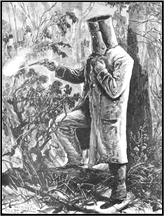
xxxxxAfter a number of skirmishes with the police, the end came in June 1880. Learning that police reinforcements were arriving by train, the gang took over the town of Glenrowan and, having herded about sixty hostages into the local inn, forced railway workers to rip up the track. But the plan misfired. One of the hostages, the local school teacher, was allowed to go free, and he stopped the train before it met with certain disaster. The large contingent of police aboard the train then laid siege to the inn and the gang’s fate was sealed. The shoot out began around 3 a.m. The four outlaws, wearing their crude suits of armour, held out for close on nine hours, but weighed down by their bulky steel plates, they were unable to mount their horses and make their getaway. Ned Kelly, having managed to escape on foot, returned to rescue his brother and friends, but by that time Byrne had been killed and the other two were unable to leave the inn. There followed a futile gunfight with the police -
xxxxxLater that year he was tried, convicted of murder, and despite a massive public petition in favour of his reprieve, was hanged at Old Melbourne Gaol in the November. He was buried in an unmarked grave somewhere within the prison walls, but he has lived on as a hero in Australian folklore, admired by many for his courage, determination, and his sympathy for the underdog. Such laudable traits are remembered today in the colloquial expression “as game as Ned Kelly”, but -
xxxxxIncidentally, immediately after his execution his head was cut off and a death mask was made (a normal procedure for executed bushrangers). Medical students then dissected the body. What was left of him was buried, but the whereabouts of his skull is still unknown. ……
xxxxx…… It is said that when he was captured a paper in one of his pockets referred to the establishment of a “Republic of North-
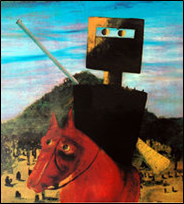
xxxxx…… Needless to say, over the years Ned Kelly and his exploits have been the subject of many films, many books and many documentaries. These, plus the stories and songs he has inspired, have provided a welcome boost for the Australian tourist industry! ……
xxxxx…… Among the artists who have put the Kelly legend on canvas is the Australian Sidney Nolan (1917-
xxxxx…… According to some accounts, moments before his death Kelly uttered his famous last words: “Such is life”. Ironically, ten days later the judge who sentenced him to death by hanging was himself chocked to death by a serious congestion of the lungs.
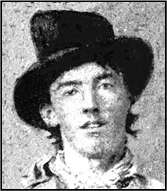 xxxxxButxthe Australian “outback” was not the only area in the world where the upkeep of law and order was threatened by the gunman. In the American “Wild West”, for example, this year -
xxxxxButxthe Australian “outback” was not the only area in the world where the upkeep of law and order was threatened by the gunman. In the American “Wild West”, for example, this year -
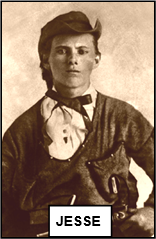 xxxxxAndxit was soon after this -
xxxxxAndxit was soon after this -
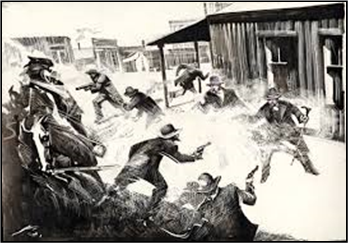 xxxxxAndx1881 saw the famous Gunfight at the O.K. Corral in Tombstone, Arizona, a 30 second burst of fire that has gone down in history as the classic shootout of the Old West. It occurred in the October when the city marshal Virgil Earp (1843-
xxxxxAndx1881 saw the famous Gunfight at the O.K. Corral in Tombstone, Arizona, a 30 second burst of fire that has gone down in history as the classic shootout of the Old West. It occurred in the October when the city marshal Virgil Earp (1843-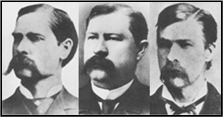 wounded. The illustration shows the
wounded. The illustration shows the
Including:
Outlaws of the
American Wild West

Vb-
xxxxxNed Kelly, the famous Australian bushranger (bandit), became an outlaw in 1878 when -


